Sloping garden ideas: 20 landscaping and styling solutions for plots on a hill
Take a look at our stylish sloping garden ideas and transform your tricky plot into a beautiful and functional space
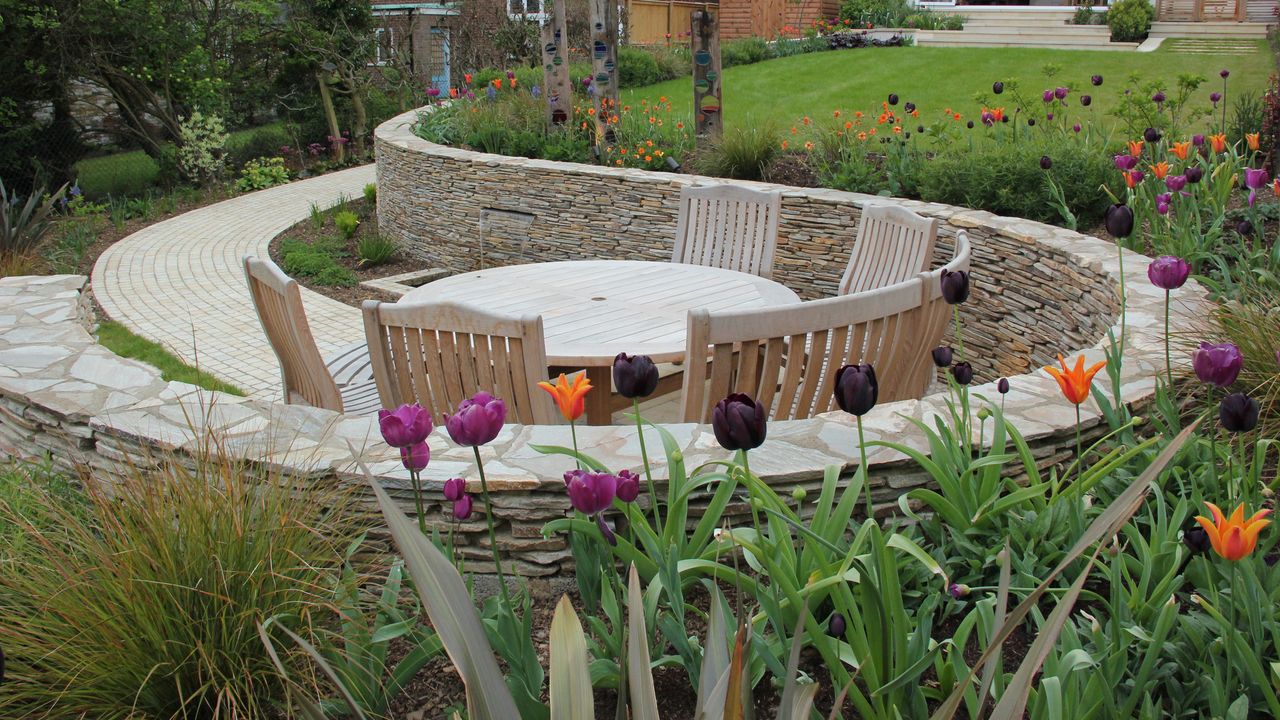

Finding sloping garden ideas can seem tricky at first. But it turns out that gardens on a hill can offer plenty of opportunities that a flat site simply can't. Yes, a bit more planning is involved, and some professional input when it comes to calculating retaining walls and drainage. Plus, plenty of muscle power is needed when it comes to re-shaping the plot. But, the end results are often some of the most breathtaking and interesting outdoor spaces out there.
Choose from super-chic, contemporary plans that include neat tiers, smartly rendered retaining walls, and slick water features, or go for wilder and more relaxed plant-packed borders, informal mown paths and rippling streams. The choice of hard landscaping materials is endless, with each offering distinct characteristics. Even practical necessities such as safety railings, steps and drainage channels can become eye-catching design features, that add personality to the final look.
So, sit back, take a look at our favorite ideas, and then start dreaming up your masterplan for your sloping garden ideas. And if you want even more inspiration for your outdoor space, head over to our garden layout ideas feature.
1. Surround a seating spot with levelled borders

Sloping garden ideas can help to show off your borders
Sloping garden ideas can be used to create show-stopping impact, as seen in this plot. The eye is drawn upwards by the wooden-cladded flowerbeds, which cocoon a verdant lawn. Curved steps add to the rustic feel.
Meanwhile, the seating space is given plenty of shelter, positioned on a decked area at the same level as the house. The result is a breathtaking view where all aspects of the garden can be appreciated at once.
Take a look at our outdoor seating ideas for more stunning designs.
2. Brighten the space with pale walls
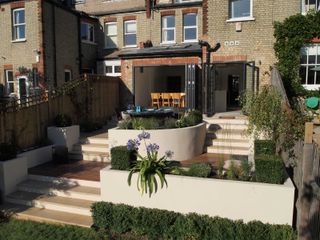
This tiered plot designed by Living Gardens demonstrates how sloping garden ideas can be used to create a modern, attractive space that all the family can enjoy.
There's plenty of room to entertain on the hardwood deck. Above, a paved seating area is surrounded by a curved planter, which softens the design and provides soothing visual interest. A lush lawn takes up the lower level of the plot.
One of our favorite things about this scene, however, is the choice of materials and colors. The pale hues bounce light around, helping to open up the space and adding to the clean, elegant vibe. The resulting look feels airy and relaxed, and makes a wonderful backdrop to the verdant planting and dazzling agapanthus.
Need more family garden ideas? Take a look at our feature.
3. Add a soothing vibe with curved features
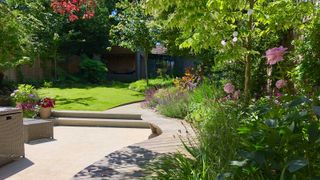
Garden designed by CITYSCAPERS
Slopes don't have to be flattened – they can provide character and opportunity for interesting design. This garden has a gentle slope, most of which was kept and turfed, explains Nigel Gomme, Landscape Designer of CITYSCAPERS.
On one side, a series of tiered level beds cuts into the area. These step up in sync with the slope, with a stepped path snaking through them. We love the gentle curves, which are mirrored by the wooden bench. Together, they offer an organic, pleasing vibe.
'On the other side of the lawn, we created a small stream that uses the natural fall in the land to meander down to a pond set into the patio by the house,' Nigel says. 'So in a single garden, the sloping topography of the site is expressed in three contrasting yet complementary ways and mostly, in fact, by keeping the slope.'
4. Try a series of small terraces
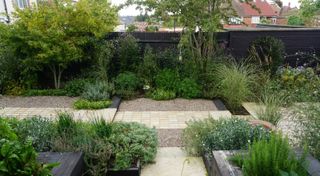
Garden designed by Fenton Roberts Garden Design
'You can sometimes flatten a whole garden but you will often be left with a large height difference on one side or at the end,' explains Jo Fenton of Fenton Roberts Garden Design. 'This will require a retaining wall which can be very costly and can introduce issues with overlooking your neighbors.'
Jo demonstrates an alternative approach to sloping garden ideas in this gorgeous plot. 'In this garden we worked with the slope by designing a series of small terraces. The slope across the garden is dealt with by introducing two sets of raised beds where the clients grow their vegetables and herbs.' It's functional, stylish, and the shallow levels add visual interest to the garden.
Don't forget to check out our guide to raised garden beds if you want to get started on your own.
5. Plant billowing borders

Garden designed by Fenton Roberts Garden Design
'Sloping sections of a garden can be hidden within the planted areas enabling other areas to be flattened for practical use,' says Jo Fenton of Fenton Roberts Garden Design.
'This steeply sloping garden was too extreme to flatten out entirely. Here, we mixed sloping flowerbeds with two paved terraces and a lawn. A narrow access path bisects this large planted area enabling the maintenance to be carried out.'
Adding plenty of height with textural plants adds a sense of romance and drama to the zone. This look would work perfectly as part of our cottage garden ideas.
6. Add statement steps to your sloping garden ideas
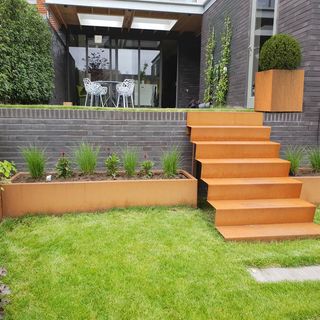
These Corten Steel garden stairs by Adezz at Flora Select make a striking feature for sloping garden ideas
Whether you are linking terraces or adding definition to a steep slope, a set of practical and eye-catching steps will help define and add structure to the outside space.
A simple stairway built from blocks, timber sleepers or deckboards will of course do the job but can take up valuable floorspace. Instead, opt for some prefabricated metal steps – such as Corten steel designs – for your sloping garden ideas. Not only do they look rather chic and introduce a gravity-defying edge to any design, but they can hover over borders and have a minimal footprint too.
They make a great choice if you love our modern garden ideas.
7. Mix smart steps and sloping beds

Hardwood decking steps link different areas of this garden designed by Andy Sturgeon and built by Construction Garden Builders
Graceful and easy on the eye – setting steps flush into a planted slope is not just practical but an elegant solution for sloping garden ideas. Solid and distinct, the secret is to make sure the size of each step is right for comfortably strolling up and down and that the width is generous enough to make a bold statement, especially when surrounded with lush planting.
Think carefully about choosing materials and the finished look. In this design, the dark hardwood steps echo the bold windows of the house but keep the look smart, yet organic too.
Looking for more inspiration? Check out our garden steps ideas feature.
8. Use gabions as a retaining wall
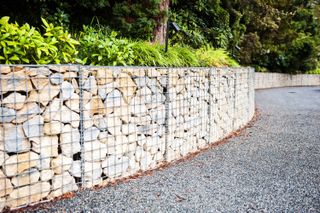
This gabion wall is a striking garden feature. Designed by Andy Sturgeon and built by Construction Garden Builders
Retaining walls are key to terracing sloping garden ideas and can become striking garden wall ideas too. There are plenty of options available and these vary widely in cost, planning and installation.
Blockwork walls – rendered or left bare – will require careful planning and preparation, as well as meticulously calculated drainage channels. Stone-filled gabions – such as these pictured – are a handy solution as not only are they strong enough to support hefty banks of soil, they look attractive and crucially let rainwater filter through.
Gabion sizes range from 0.5m to 2m wide baskets and can be made from rigid welded mesh or flexible woven wire.
9. Make room for sunken seating
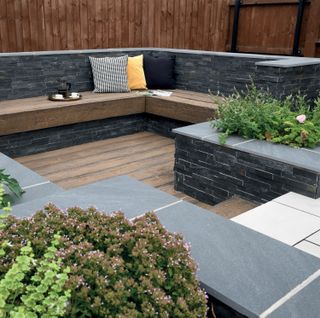
These black-blue slate walling slips from Bradstone are a smart choice for modern sloping garden ideas
Introducing tiered garden ideas to a steeply sloping plot is an effective way to manage the space and create a series of small but useable areas too. You will need to call in the professionals to calculate the best layout and the size and load of any retaining walls, but the result will be well worth it.
Use your sloping garden ideas to look for clever ways to make the most of limited space. Retaining walls can easily double up as built-in lounge seating and planters so think carefully about the number of guests you wish to accommodate. Keep the decor simple and opt for a super chic stone and timber combo.
10. Build in steps and borders
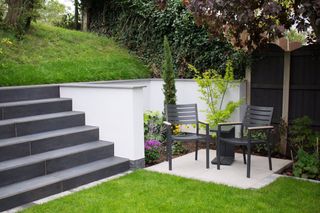
Keep it sleek and modern with these Casarta slate steps from Marshalls
Adding return walls to a retaining wall and flight of steps can create a striking feature in steep gardens on a slope. A bold combination of materials – such as this pairing of slate and white rendered walls – adds drama to the finished result.
As well as being supremely practical, it also helps to visually link two contrasting styles of gardening – smart and contemporary on the lower level and soft and wilder at the top. The short return walls also help to showcase the carefully selected border plants.
11. Go for tiered planters
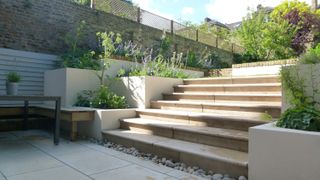
Jura Beige Limestone Step Treads from London Stone are a timeless choice for any garden scheme
Dividing a steeply sloping garden into tiers doesn't have to result in a space that's split up by hard, straight lines. There are plenty of clever ways to soften and blur these divisions, particularly if you're searching for small garden ideas.
One way is to use stepped, angular planters. Or, go for fewer, larger planting pockets for your sloping garden ideas – these could be built into your new landscaping or added as freestanding containers. Fill with tall, airy, year-round planting that will soften the harsh, straight lines without casting heavy shade. There's lots of expert advice on designing flowerbeds in our guide to garden borders.
12. Divide with sweeping curves
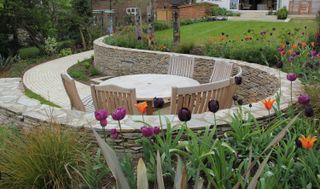
This beautiful garden designed by Amanda Broughton Garden Design uses sweeping paths and stone walls as part of its sloping garden ideas
Disguise a steep but sizeable plot by introducing sweeping garden path ideas and an equally curvy retaining wall to your sloping garden ideas. Not only does this subtly divide up the sloping site into a series of terraces, but it also adds a sense of horizontal movement too.
In this beautiful design, a snaking stone wall creates a cozy seating area and also provides the opportunity for a falling water feature.
13. Add character with railings
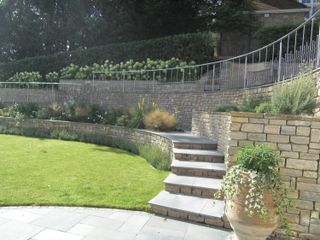
This garden on a slope was designed by Lindsey Evans Garden Design
Steep, terraced gardens on a slope must comply with building and safety regs but it's also a great excuse to invest in some super stylish railings. Choose from off-the-peg or handcrafted, bespoke designs to complement your garden's style and setting.
With so many different materials and finishes to choose from, it's worth researching the options before committing for your sloping garden ideas. Polished stainless steel and aluminium tubular designs give off a truly contemporary and nautical feel whereas wrought iron is much more traditional and ornate in its possibilities.
Fancy a pop of color? Then go for powder-coated steel railings that can be finished in one of hundreds of RAL shades. Wood, tension wire between wood and metal posts and even toughened glass are also stunning options. We have lots more inspiration in our decking railing ideas feature.
14. Use sloping garden ideas to showcase planting

Large flowerbeds and varied planting are key features of this sloping garden by Acres Wild Garden Design
A garden that slopes up from the house or patio is the perfect opportunity to show off beautiful planting. Keep your landscaping ideas to a minimum – a flight of timber steps or duckboards leading from A to B will link and punctuate the space without taking away from the planting.
When it comes to planning borders for your sloping garden ideas, introduce layers of shrubs and trees for year-round form and structure. Then, fill in the gaps with vibrant and textural perennials and ornamental grasses.
Encourage low-growing evergreens and foliage to spill over and soften the hard edges of any steps, patios or retaining walls, and use climbers over fences to complete the abundant look.
15. Terrace with easy-care decking
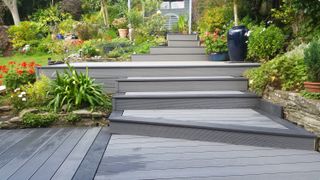
Cladco’s Hollow Stone Grey and Black Charcoal Solid Bullnose Decking Boards were installed in this garden by Gull Rock Decking
The best composite decking is a smart, no-fuss and versatile material – perfect for creating steps and usable levels in a sloping garden.
Needing less upkeep than timber deck boards, these vinyl-wrapped planks come in a wide variety of finishes and profiles and can be easily installed to suit your individual site.
Head over to our decking ideas feature for more inspiration.
16. Take a soft approach
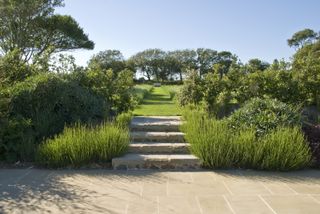
This large garden by Acres Wild Garden Design has a beautiful, natural feel to its landscaping design
Gardens on a slope can be given a wild touch by playing it simple and keeping hard landscaping to a minimum.
If you have a gentle slope, a neatly mown path leading through a flower-laden meadow is an elegant solution that puts nature and natural form centre stage. Add some drama to the look by keeping the layout symmetrical. Then, place a striking sculpture or one of the best garden benches at the far end of the path – a perfect solution for long garden ideas on a slope.
17. Dig out a sunken patio
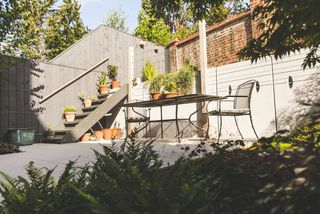
Designed by Nordland Landscapes, this garden makes the most of its sloping plot
Maximise your garden's usable space by digging out the base of the slope to create a sunken patio. An enclosed seating area instantly creates a cozy feel and offers an extra degree of shelter and warmth, so is perfect for those cooler months.
A retaining wall will have to be planned and constructed by a garden designer or landscaping professional to ensure it can support the weight of soil behind it and deal with any resulting drainage issues. This smart, urban design involved installing a hidden slot drain to handle any sudden downpours.
Find more patio ideas in our guide.
18. Include falling water
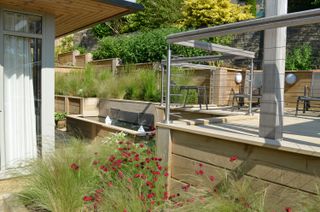
A modern water feature links different areas of this garden designed by Susan Dunstall
Gardens on a slope – whether they're terraced or left angled – provide the ideal opportunity to bring in flowing water. It could be a gently babbling stream that meanders down through rocks and is niftily recycled back to the top by a hidden pump and water reservoir, or something decidedly more contemporary.
In this eye-catching garden, the very steep site is divided into two distinct levels with a pair of stunning water chutes and a raised pond built into the lower wall. If you want to incorporate something similar in your garden design, you'll find plenty of inspiration in our water feature ideas gallery.
19. Reinvent the rockery
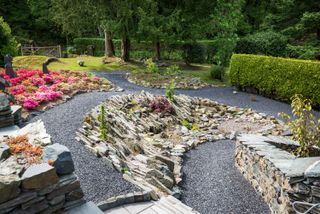
This modern take on a rockery was designed by Wildroof Landscapes
Let the beauty of natural stone and Japanese gardens inspire you to transform a dull, sloping site. Fine gravel paths weaving through rocky borders planted with low-growing sedums, alpines, azaleas and statuesque conifers provides beautiful year-round color and interest. And, it creates an instantly calming mood, too.
This Japanese inspired tea garden by Wildroof Landscapes is a crevice garden full of character and texture. Local stone laid side on and packed close together makes a bold contrast with laid dry-stone walls and boulder-edged planting areas.
If you love the look, be sure to check out our small Japanese garden ideas, too.
20. Go on – add a slide!
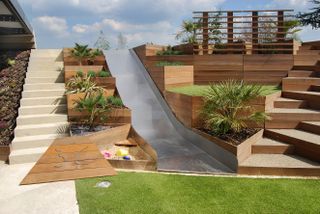
This family garden designed by Eldridge London turns the sloping nature of the plot into a fun garden feature for the kids
There's no need for an excuse – every sloping garden surely has to have a slide built in! It could be a colorful moulded or aluminium children's version that you bed neatly into a grassy bank, but why not go all out and choose a beautifully-crafted design that everyone can enjoy?
This gorgeous garden includes intricate cedar-clad planters, a lawn, and angled steps. The stainless-steel slide is extra wide and adds a minimal but striking feature for uber-modern gardens on a slope.
We've got plenty of ways to keep kids entertained outdoors in our garden activities for kids feature – head on over to take a look.
How do you drain a sloping garden?
When it comes to providing drainage for your sloping garden ideas, 'Soakaways (essentially a hole in the ground filled with rubble) are a brilliant, sustainable option,' says Garden Designer Jonathan Martin of Living Gardens.
This is because, 'You're not sending excess water into drainage but taking it away from the surface to soak into the soil below.'
Can you flatten a sloped garden?
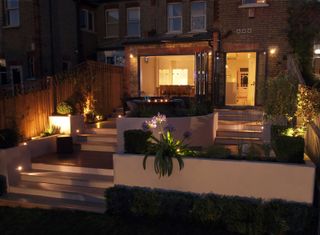
Sloping garden ideas can be brought to life with gorgeous garden lighting, like in this garden designed by Living Gardens
Completely flattening a significant slope is difficult (and generally, expensive). But instead, you can opt for multiple levels, as Garden Designer Jonathan Martin of Living Gardens explains...
'You can't easily change the difference in height between the top and the bottom of your garden, so what we usually opt for is a tiered design,' he says.
'In the pictured garden, the gradient was so steep that we needed to step down three steps straight out of the house. This is followed by two tiers down to the lawn. Even then the lawn slopes, so to deal with drainage we dug two soakaways, one a third of a way down the lawn, and one two thirds of the way down, to take the excess water away from the surface.' We adore the use of garden lighting ideas here, too.
Nigel Gomme, Landscape Designer of CITYSCAPERS adds, 'A sloping garden is typically viewed as problematic but as a designer I love slopes as they embody a kind of three dimensional potential that can lead to unique and really engaging spaces.'
'You can cut into a slope, you can cantilever out over it, you can add a rubber liner and rocks and pebbles and run water down it to create a stream – there's so much latent potential to explore. So my advice would be don't rush to flatten it – think of a slope as a resource rather than a problem and be inventive in how you engage with it.'
Do I need permission to level my garden?
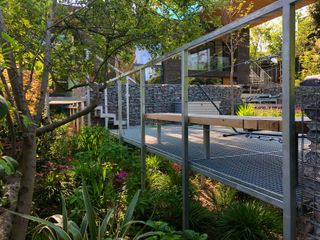
Clever sloping garden ideas can include fabulous terraced structures, like in this garden designed by CITYSCAPERS
In general, you don't need permission to level your garden as part of your sloping garden ideas. 'But there are caveats,' says Nigel Gomme, Landscape Designer of CITYSPACERS. 'The first thing you need to consider are trees within the garden. Changing soil levels within their root zones, which are generally twice as wide as the canopy, can damage or even kill trees,' he explains. 'If there are tree protection orders on any trees within your garden you could be breaking the law. So, it is well worth seeking professional advice before you start.'
'Other things to consider include boundary walls and fences. How will level changes within the garden affect your neighbor's wall or fence, for example? If you’re dropping the ground level quite a bit, boundary walls may need underpinning which is an expensive undertaking.'
'However, with thought, there can be ways around some of these problems. We recently landscaped a garden [see above] that steeply sloped away from the house and was also pitched to the side, with protected trees throughout,' Nigel continues. We couldn't change soil levels, build walls or lay paving within the root zones of the trees and the client wanted level surfaces. So, we built raised platforms, decks and walkways that appear to float over the sloping landscape: the trees were unharmed, attractive practical level areas were created for entertainment and outdoor dining, and the sloping terrain was basically left untouched. The point here is that to level a garden you don't necessarily have to level the ground itself, you can build level structures above it instead.'
Looking for more inspiration? Head over to our guide on landscaping around trees.
Garden Designer Jo Fenton of Fenton Roberts Garden Design adds, 'We often encounter the problem of a steep drop from the house into the garden leaving people feeling disconnected from their outdoor space. This can be solved by adding a raised terrace to the back of the house. However, if this raised area is over 30cm above ground level you will often have to apply for planning permission. This is because the terrace may overlook your neighbors.'

Jill puts her love of plants and all things garden related down to the hours spent pottering around with her Nan and Grandad when she was little. Today she is lucky enough to have a garden of her own in Surrey, England, and spends much of her time writing about them too.
-
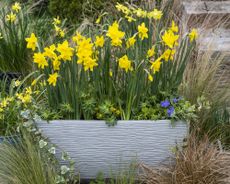 An Update on Gardeningetc
An Update on GardeningetcA word from our publisher
By Beth Murton Published
-
 Do you need to chit potatoes? Find out what the experts say
Do you need to chit potatoes? Find out what the experts sayGrow Your Own Learn how to chit potatoes before planting them in the ground and you’ll be on your way to getting an earlier and bigger harvest
By Drew Swainston Published
